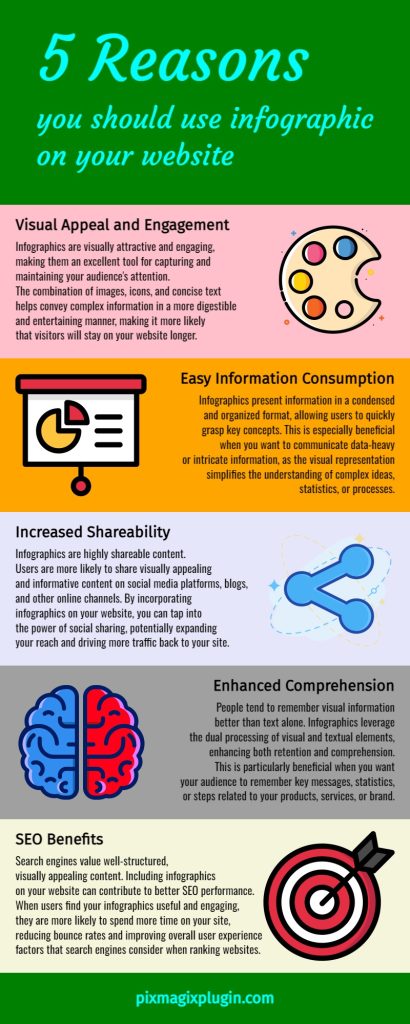In the dynamic landscape of online content, where attention spans are fleeting and information overload is a common challenge, the need for visually appealing and easily digestible content has never been more crucial. One powerful tool that stands out in this regard is the infographic. By incorporating infographics into your website, you can transform the way you communicate with your audience, providing a host of benefits that go beyond mere aesthetics. Here are five compelling reasons why you should consider integrating infographics into your website content strategy.

1. Visual Appeal and Engagement: Captivating Your Audience
In the world of digital content, first impressions matter. Infographics, with their vibrant colors, icons, and sleek design, instantly captivate your audience’s attention. By presenting information in a visually appealing manner, you create an engaging user experience that encourages visitors to explore your content further. This visual allure can be the key to keeping users on your site longer, increasing the chances of converting them into customers or loyal followers.
2. Easy Information Consumption: Simplifying the Complex
Complex data and intricate concepts can be challenging to convey through traditional text alone. Infographics provide a solution by condensing information into a visually organized format. Charts, graphs, and concise text work in harmony to simplify complex ideas, making them more accessible and easier to understand. This not only benefits your audience but also positions your brand as a reliable source of clear and comprehensible information.
3. Increased Shareability: Expanding Your Reach Through Social Media
In the age of social media, shareability is a powerful metric for online success. Infographics are inherently shareable, as users are more likely to share visually appealing and informative content. By incorporating infographics into your website, you tap into the vast potential of social sharing. When your audience shares your infographics on platforms like Facebook, Twitter, or LinkedIn, you extend your reach, driving more traffic back to your site and increasing your brand’s visibility.
4. Enhanced Retention and Comprehension: Making Information Memorable
People remember visuals better than text alone. Infographics leverage this innate preference for visual content, enhancing both information retention and comprehension. Whether you’re communicating key product features, industry statistics, or a step-by-step process, infographics help your audience remember and understand crucial information. This can be a game-changer when it comes to reinforcing your brand messaging and establishing a lasting connection with your audience.
5. Search Engine Optimization (SEO) Benefits: Improving Your Online Visibility
Search engines reward websites that offer a positive user experience. Infographics contribute to this by providing well-structured, visually engaging content. When visitors spend more time on your site exploring infographics, it reduces bounce rates and signals to search engines that your content is valuable. This positive user engagement can translate into improved SEO rankings, helping your website stand out in search results.
Conclusion
Infographics are not just aesthetically pleasing elements to add to your website; they are powerful tools that can elevate your content strategy, enhance user experience, and boost your online presence. By leveraging the visual appeal and communicative efficiency of infographics, you position your brand as a source of valuable and easily consumable information, fostering a deeper connection with your audience in the digital realm.
